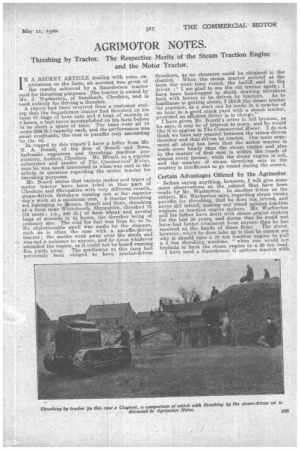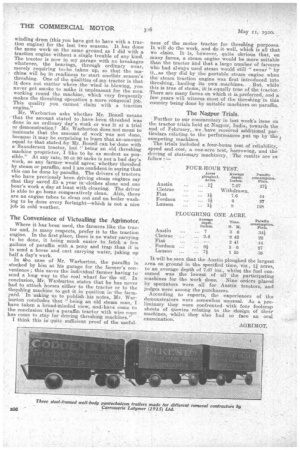AGRIMOTOR NOTES.
Page 21

Page 22

If you've noticed an error in this article please click here to report it so we can fix it.
Threshing by Tractor. The Respective Merits of the Steam Traction Engine and the Motor Tractor.
IN A RECENT ARTICLE dealing with some experiences on the farm, an account was given, of the results achieved by a Sannderson tractor used for threshing purposes. The tractor is owned by Mr. J. Warburton, of Sandbach, Cheshire, and IS used entirely for driving a thresher. A re-port had been received from a customer stating that the Sanderson tractor had threshed on his farm 87 bags of best oats and 9 bags of seconds in 8 hours, a feat never accomplished on his farm before in so short a space of time. The bags were all 10 score (200 lb.) capacity each, and the performance was most creditable, the cost in paraffin only amounting to 12s. 6d.
In regard to this report I have a letter from Mr. N. A. Bonell, of the firm of Bonell and Sons, hydraulic engineers and threshing, machine proprietors Anthem, Cheshire. Mr. Btnell, as aregular subscriber and reader of The Commercial' Motor, says he was much interested in what ,was said in the article in question regarding the motor tractor for
threshing purposes. . .
Mr. Bonell states that various makes and types of motor tractor have been tried in that part of Cheshire and Shropshire with very different results, steam-driven. threshers tuxning out a far. superior day's work at a minimum -cost. A tractor threshing set belonging to Messrs. Bonell and Sons, threshing at a farm near Whitchurch, Shropshire, threshed 75 (12 score; i.e., 240 lb.) of best wheat and severalbags of seconds in 4i hours, the thresher being of ordinary size. The cost for fuel was from 6s. to 7s. No objectionable smell was made by the steamer, such as is often the case with a paraffin-driven tractor; • the smoke went away over the sheds and . was not a nuisance to anyone, and no noise whatever attended the engine, as it could not be heard running five yards away. The gentleman at this farm had previously been obliged to have tractor-driven • threshers, as no steamers could be obtained in the district. When the steam tractor arrived at the farm the next time round, the bailiff said to the driver :" I am glad to see the old tractor again ; I have been humbugged to death drawing threshers here with horses to be driven by tractors. As to • handiness in getting-about, I think the steam tractor far superior, as a start can be made in a quarter of an hour in a good -stack yard with a steam tractor, provided an efficient driver is in charge!' I have given Mr. Bonell's letter in full because, as he says, it may be of interest to many, and he would like it to appear in The Commercial Motor. I do not think we have any quarrel between the steam-driven thresher and that driven by tractor. Our main argument all along has been that the motor tractor is much more handy than the steam engine and also in the matter of first cost is within the reach of almost every farmer, while the steam engine is not, and the • number of steam threshing sets in the country is insufficient to go round during the season.
Certain Advantages Offered by the Agrimotor.
Before saying anything, however, I will give some more observations on the subject that have been -made by, Mr. Warburton. In another letter on the subject, Mr. Warburton says, regarding steam versus paraffin for threshing, that he does not intend, and never did intend, makingany stand against traction engines or traction engine makers. Mr. Warburton and his father have dealt with steam engine makers for the last 30 years, and states that be could not have had better, treatment from anyone than he has received at the hands of these firms. The stand, however, which he does take up is that he cannot see why it should take a 10 ton traction engine to pull a 5 ton threshing machine, "when you would not hesitate to hook the steam engine to a 25 ton load. have used a Saunderson CS' pattern tractor with winding drum (this you have got to have with a traction engine) for the last two seasons. It has done the same work on the same ground as I did with a traction engine without a single trouble of any kind. The tractor is now in my garage with no breakages whatever, the bearings, through ordinary wear, merely requiring to, be taken up, so that the ma,chine will be in readiness to start• another season's threshing. One of the qUalities of my tractor is that it does not matter where :the wind is .blowing, you never get smoke to make it unpleasant for the men working round the machine, which very frequently makes the threshing opevition a more congenial job. This quality you cannot'. claim with a traction engine."
Mr. Warburton asks whether Mr. Bonell ane_ans that the amount stated to ,have been threshed was done in an ordinary day's work or was it at a trial or demonstration? Mr. Warburton does.not mean to insinuate that the amount of work was not done, because it may be surprising to learn that an-amount equal to that stated 'by Mr. Bonen can be done with a Sa,underson tractor, but ." being an old threshing machine proprietor, I like to hp as modest as possible." At any rate, .80 or 90 Sacks is not a bad day's Work, as any farmer would agree; whether threshed by steam or paraffin, and I am confident in saying that this can be done by.paraffin. The drivers of tractors who have previously been driving steam engines say that they saved £5 a year iirclothes alone and one hour's work a day at least with cleaning. The driver is able to go home comparatively clean. AlS'o, there are no engine tubes to clean out and no boiler washing to be done every fortnight—which is not a nice job in cold weather.
The Convenience of Victuallitlg the Agrimotor.
Where it has been used, the farmers like the tractor and, in many respects, prefer it to the traction engine. In the first Place, there is no water carrying to be done, it being much easier to fetch a, few gallons of paraffin ,with ,a pony and trap than it is to send a horse and cart carrying water, taking up half a day's work. In the case of Mr. Warburton, the paraffin is stocked by him at his garage for the farmer's convenience; this saves the individual farmer having to send a long way to the coal wharf for the oil. In conclusion, Mr. Warburton states that he has never had to attach horses either to the tractor or to the threshing machine to get it in position in the farmward. In asking us to publish, his notes, Mr. Warburton. concludes that "being an old steam man,. I have taken a broad-minded view, an&have come to the conclusion that-a paraffin tractor with wire rope has come to stay for driving threahing ma-chines."
I think this is quite sufficient proof of the useful ness of the motor tractor for threshing purposes. It will do the work, and do it well, which is all that we claim. It is, however, quite obvious that, on many farms, a steam engine would be more suitable than the tractor and that a large number of farmers who had alwaYs used steam would still " swear " by it,. as they did by the portable steam engine when thesteam traction engine was first introduced into threshing,. hauling its own _machines. „. But, while this is true of steam, it equally true of the. tractor.There are many farms on which it is preferred, and a few years ;will witness most of the threshing-in this country being done by suitable machines on paraffin.
The Nagpur Trials.
Further to our commentary in last week's issue on the tractor trials held at Nagpur, India. towards the end of February, we ,ha,ve received additional particulars relating to the performances .put up by the competing machines. The trials included a four-hours test of 'reliability,. speed and ,cost, a one-acre tat, harrowing, and the driving of stationary machinery. The residts are asfollow:-- It will be seen that the Austin ploughed the largest area on ground in the specified time, viz., i acres, to an average depth of 7.07 ins., whilst the fuel consumed was the lowest of all the participating machines for the work done. Nine orders placed by spectators were all for Austin tractors, and judges were among the purchasers.
According to reports, the experiences of the demonstrators were somewhatunusual. As a preliminary they were confronted with four foolscap sheets of queries relating to the design, of their machines, whilst they also had to face an oral examination.
AGRIMOT.




























